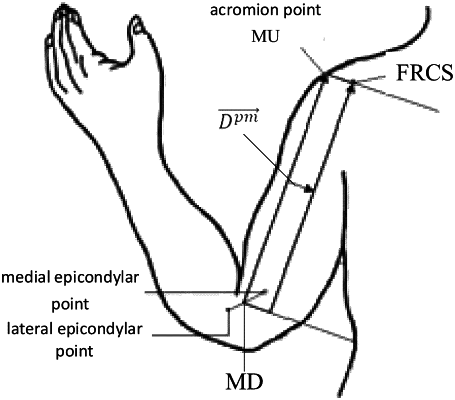| CPC A61B 5/1121 (2013.01) [A61B 5/1127 (2013.01); A61B 5/1128 (2013.01); A61B 5/7271 (2013.01)] | 9 Claims |

|
1. A positioning method of a functional rotation center of a shoulder (FRCS) based on a rigid upper arm model, comprising:
step 1: abstracting a human upper arm of a particular human into a cylinder with the FRCS as a center of a top surface of the cylinder, wherein a side surface of the cylinder models a skin surface of the human upper arm;
step 2: determining a reference axis vector of the cylinder by measuring a motion of the human upper arm;
step 3: determining a central axis vector of the cylinder and, for each given moment of a plurality of moments during the measured motion, a displacement from the reference axis vector to the central axis vector, wherein, the reference axis vector is translated in a direction perpendicular to a reference direction of the cylinder, to determine the central axis vector, wherein an amount of translation is defined by a vector Dpm and a distance from the central axis vector to each point on the skin surface of the human upper arm is equal;
step 4: correcting the central axis vector of the cylinder;
step 5: determining a height compensation of the cylinder by stretching a height of the cylinder to account for deformation of the human upper arm resulting from the measured motion, and positioning the FRCS of the human upper arm of said particular human based on the height compensation and on the corrected central axis vector, and displaying the positioned FRCS of the human upper arm of said particular human.
|